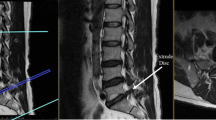Summary
After surgery necessitated by lumbar back pain syndromes, radiolucency verified by CT may appear in the sacrospinal muscle group on the operated side. This radiolucency represents muscular atrophy and is in its most severe form a result of the replacement of muscle tissue with adipose tissue. Such muscular atrophy appeared in the present series in 31 out of all 156 patients (19.9%) and in 29 out of 94 patients operated on because of radiating lumbar back pain (30.9%). The radiological appearance, extent, and HU values of this muscular atrophy are presented in detail. Only weak correlations with the multitude of clinical symptoms and signs were found in this retrospective study. The effects of irreversible muscular atrophy on the indications for surgery and physiotherapy are discussed.
Similar content being viewed by others
References
Eldevik OP, Dugstad G, Orrison WW, Haughton VM (1982) The effect of clinical bias on the interpretation of myelography and spinal computed tomography. Radiology 145: 85–89
Haughton VM, Syvertsen A, Williams AL (1980) Soft-tissue anatomy within the spinal canal as seen on computed tomography. Radiology 134: 649–655
Haughton VM, Eldevik OP, Magnaes B, Amundsen P (1982) A prospective comparison of computed tomography and myelography in the diagnosis of herniated lumbar disks. Radiology 142: 103–110
Teplick JG, Teplick SK, Goodman L, haskin ME (1982) Pitfalls and unusual findings in computed tomography of the lumbar spine. J Comput Assist Tomogr 6: 888–893
Meirsman J de, Termote J-L (1979) The influence of skeletal muscle atrophy on needle electromyography as demonstrated by computed tomography. electromyogr Clin Neurophysiol 19: 269–279
Rickards D, Isherwood I, Hutchinson R, Gibbs A, Cummings WJK (1982) Computed tomography in dystrophia myotonica. Neuroradiology 24: 27–31
Termote J-L, Baert A, Crolla D, Palmers Y, Bulcke JA (1980) Computed tomography of the normal and pathologic muscular system. Radiology 137: 439–444
Harbin WP (1981) Radiographic anatomy of the sacrospinalis muscle. Radiology 140: 630
Osborn AG, Koehler PR (1981) Computed tomography of the paraspinal musculature: normal and pathologic anatomy. AJR 138: 93–98
Bulcke JAL, Baert AL (1982) Clinical and radiological aspects of myopathies. CT scanning, EMG, radioisotopes. Springer, Berlin Heidelberg New York
Jeffrey RB, Callen PW, Federle MP (1980) Computed tomography of psoas abscesses. J Comput Assist Tomogr 4: 639–641
Mendez G Jr, Isikoff MB, Hill MC (1980) Retroperitoneal processes involving the psoas demonstrated by computed tomography. J Comput Assist Tomogr 4: 78–82
Ralls PW, Boswell W, Henderson R, Rogers W, Boger D, Halls J (1980) CT of inflammatory disease of the psoas muscle. AJR 134: 767–770
Wolverson MK, Jagannadharao B, Sundaram M, Heiberg E, Grider R (1981) Computed tomography in the diagnosis of gluteal abscess and other peripelvic fluid collections. J Comput Assist Tomogr 5: 34–38
Jend H-H, Helmke K, Heller M, Kühne D (1982) Die Computertomographie bei Fehlbildungen, entzündlichen und degenerativen Veränderungen der Wirbelsäule. RÖFO 137: 523–529
Hemmingsson A, Johnsson A, Rauschning W (1982) Attenuation in human muscle and fat tissue in vivo and in vitro. Acta Radiol [Diagn] (Stockh) 23: 149–151
See DH, Kraft GH (1975) Electromyography in paraspinal muscles following surgery for root compression. Arch Phys Med Rehabil 56: 80–83
Wilbourn AJ (1982) The value and limitations of electromyographic examination in the diagnosis of lumbosacral radiculopathy. In: Hardy RW (ed) Lumbar disc disease. Raven Press, New York, pp 65–109
Andersen PE (1982) Postoperative fölger af hemilaminectomi. In: Halaburt H, Ratjen E, Miletic T (eds) Arsmöde—nordisk forening for neuroradiologi. Aarhus
Naidich TP, King DG, Moran CJ, Sagel SS (1980) Computed tomography of the lumbar thecal sac. J Comput Assist Tomogr 4: 37–41
Junges R, Zwicker H (1982) Die Wertigkeit der CT-Untersuchung bei Bandscheibenvorfällen. RÖFO 136: 166–170
Williams JP, Joslyn JN, Butler TW (1982) Differentiation of herniated lumbar disc from bulging annulus fibrosis. Use of reformatted images. J Comput Assist Tomogr 6: 89–93
Author information
Authors and Affiliations
Rights and permissions
About this article
Cite this article
Laasonen, E.M. Atrophy of sacrospinal muscle groups in patients with chronic, diffusely radiating lumbar back pain. Neuroradiology 26, 9–13 (1984). https://doi.org/10.1007/BF00328195
Received:
Revised:
Issue Date:
DOI: https://doi.org/10.1007/BF00328195




